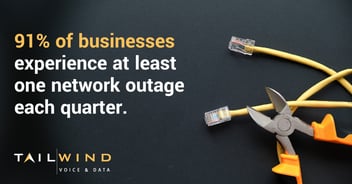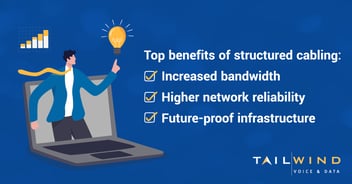A robust structured cabling system is the foundation of a high-performing communications network in any modern business. Structured cabling connects devices like computers, phones, wireless access points, and more to your voice and data networks in an organized way for superior network flexibility, reliability, and scalability.
In this guide, we'll break down everything you need to know about structured cabling – from its definition to the installation process – so that your business is equipped to meet today's technological needs with room to grow in the future.
What Is Structured Cabling?
Structured cabling is an organized approach to implementing cabling infrastructure. It connects end-user devices to phone and data networks in a way that provides more flexibility, uptime, and scalability for an organization's communications system than point-to-point cabling.
With point-to-point cabling, each device is connected to the next in the chain, often resulting in congested cabling and difficulty troubleshooting. Structured cabling systems use centralized distribution frames, making it easier to add, remove, and modify connections as your business needs change – without disrupting network operations.
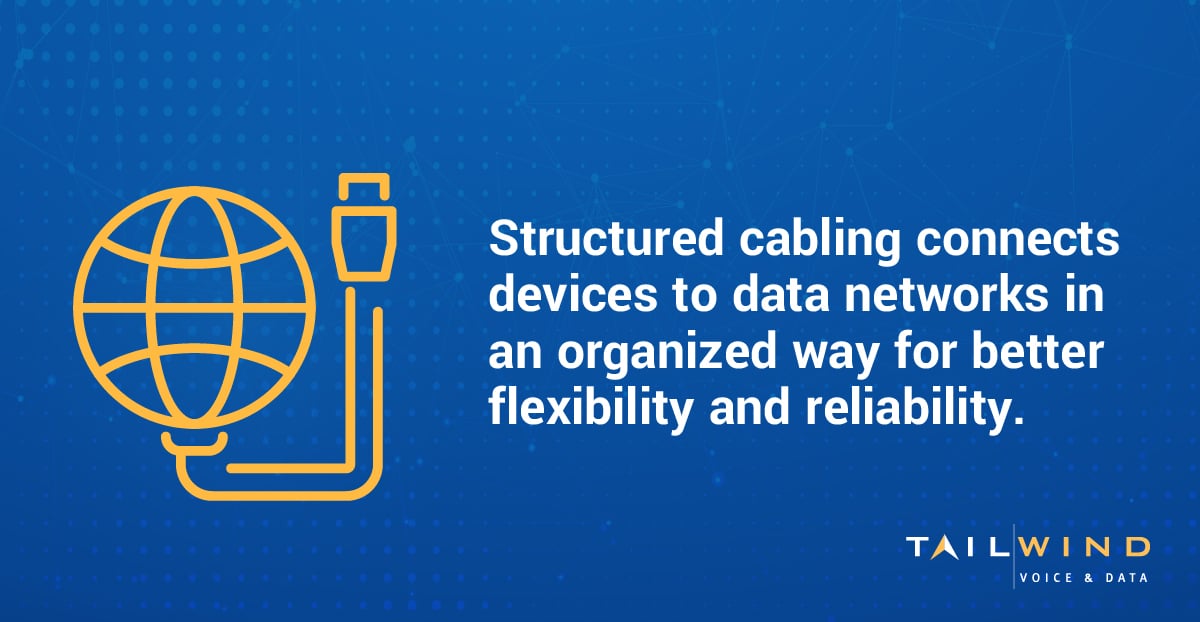
The Components Of Structured Cabling
Structured cabling consists of multiple components that, when combined the right way, provide a strong, flexible infrastructure for business communications. The six subsystems that make up a structured cabling system include:
Horizontal Cabling
A horizontal cabling subsystem connects the telecommunications enclosure to individual outlets or work areas throughout a company's ceiling, floor, or wall spaces. Horizontal cabling is the part of the structured cabling system that users interact with daily.
Backbone Cabling
Backbone cabling, also known as vertical cabling, is the core subsystem of cabling systems that connects telecommunication rooms, centralized equipment rooms, and entrance facilities, in addition to connecting separate buildings within a corporate campus.
Entrance Facility
An entrance facility is where your service provider's cabling meets your private network cabling system. Entrance facility structured cabling is the consolidation point for external data and business communication services in a building and typically includes cable routing components, network demarcation points, and protection devices to guard against electrical surges.
Telecommunications Rooms
A telecommunications room, often called a telecommunications enclosure, houses the equipment that manages the telecommunications cabling within a building. This space serves as the central hub for the structured cabling system and may include server racks, switches, routers, and patch panels.
Equipment Rooms
An equipment room is a centralized space that houses more substantial equipment and consolidation points, including mainframes, servers, and switches that need a controlled environment to work optimally.
Work Area Components
Work area components are all the components of the structured cabling system where your users interact with the network with devices such as computers, phones, and printers. This subsystem includes the cables that run from wall plates and patch panels to end-user devices.
How To Install Structured Cabling
1. Planning & Design
- Evaluate current and future network needs.
- Map out a floor plan, marking workstation, server, and equipment locations.
- Select the right cable types (e.g., fiber optic, Ethernet) and supporting hardware.
2. Selecting Components
- Choose high-performance cables and infrastructure for optimal data transmission.
- Ensure all components, including connectors and patch panels, are compatible.
3. Installation & Organization
- Route cables efficiently through floors, ceilings, and walls.
- Label and arrange cabling systematically for easier management.
- Establish structured cross-connect points for scalability.
- Terminate cables properly and connect to network devices.
4. Testing & Verification
- Check cable integrity and performance to meet industry standards.
- Resolve any issues before full deployment.
5. Documentation & Maintenance
- Keep detailed records of cable routes, terminations, and specifications.
- Schedule regular inspections to ensure long-term network efficiency.
What Is Low-Voltage Structured Cabling?
Low-voltage wiring operates on lower electrical currents than a building's primary electrical services. It's often used to power IT systems that don't require high power consumption, such as VoIP phones and Wi-Fi access points. When implemented correctly, low-voltage cabling systems can help businesses reduce their energy footprint while maintaining a high standard for their communication technologies.
Common low-voltage cabling systems include:
Voice & Data Cabling
Voice and data cabling facilitates the transmission of audio and data across an organization's network. Often used with VoIP technology, voice and data cables need to meet certain standards, such as Category 5e or Category 6, to provide clear voice transmission and reliable connectivity.
Ethernet Cabling
Ethernet cabling is used to connect devices to the local network, typically where high-speed data transfer between computers, servers, and other network devices is necessary. Cat5e and Cat6 Ethernet cables are the most common for business applications. Higher category numbers provide faster data transfer speed and more bandwidth, which is essential for businesses that depend on real-time data.
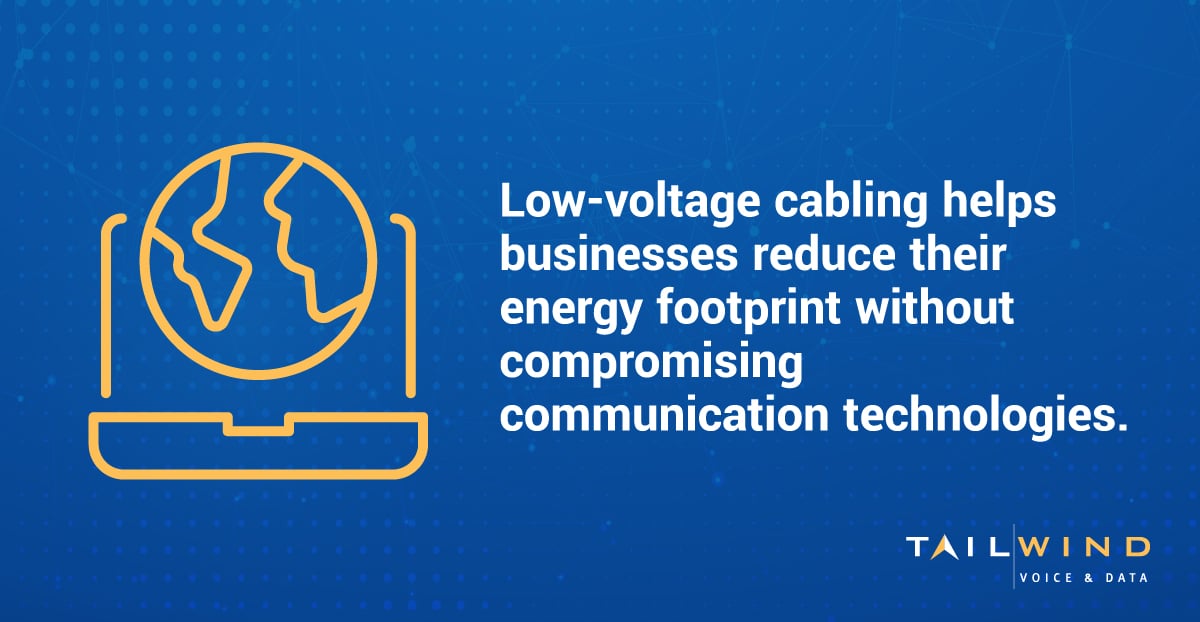
Security System Cabling
Security system cables power systems that keep your business secure, such as surveillance cameras. The low-voltage cabling must support power and video transmission for network video recorder equipment, requiring careful planning to ensure no loss of video quality.
Intercom Cabling
Intercom cabling systems are used for internal communication within a building or campus. These systems need dedicated cabling to transmit audio and video between master stations and substations, especially in larger networks where clear communication is important for both daily operations and emergency situations.
When Should Businesses Use Low-Voltage Structured Cabling?
There are several instances when implementing a low-voltage structured cabling system makes sense for a business, including:
Commercial Building Construction
Commercial buildings require well-designed, low-voltage wiring pathways. By installing structured cabling during the initial construction of a new commercial building, you can more easily avoid mistakes that affect the performance of your low-voltage system. Trying to retrofit cabling after the building is complete is exponentially more difficult and costly.
Office Relocations
If your business is moving to a new office space, you have an ideal opportunity to outfit the new office with a more efficient structured cabling solution. New cabling can cost-effectively support the latest network speeds and technology while avoiding having to reuse older voice and data cabling that may be outdated or inadequate.
Expanding Office Network Capacity
Structured cabling makes adding network bandwidth, new cable runs, additional connections, and higher speeds easy. If you have plans to grow your business technology systems, the modularity of structured cabling supports capacity expansion seamlessly.
How Structured Cabling Improves Network Reliability
A well-designed structured cabling system is essential for ensuring a stable, high-performance network. Poor cabling can lead to frequent disconnections, slow data transmission, and increased downtime. Below, we explore how structured cabling enhances network reliability and best practices to maintain consistent performance.
Reduces Cable Clutter & Improves Organization
Structured cabling replaces disorganized point-to-point wiring with a centralized and well-labeled infrastructure.
Reduces human errors caused by messy wiring, which can lead to accidental disconnections or signal interference.
Makes maintenance and troubleshooting easier, as cables are properly routed and documented.
Minimizes Signal Interference & Crosstalk
Poorly installed cables can suffer from electromagnetic interference (EMI) caused by power lines, fluorescent lights, and other electronic devices.
Shielded cabling (Cat6a, fiber optic) helps reduce crosstalk (signal leakage between wires) and maintains high data transmission speeds.
Keeping network cables separate from power cables prevents performance degradation and signal noise issues.
Supports High-Speed Data Transmission
Structured cabling is designed to handle high-bandwidth applications, ensuring consistent performance for VoIP, cloud computing, and video conferencing.
Using Category 6, 6a, or fiber optic cables ensures future scalability while maintaining low latency and high-speed connections.
Prevents Connection Failures & Downtime
Poorly crimped connectors, loose terminations, and damaged cables can lead to frequent disconnections.
High-quality connectors, proper cable routing, and cable testing before deployment ensure reliability.
Structured cabling supports redundancy by allowing alternative network paths in case of cable failure.
Simplifies Network Upgrades & Expansion
A well-planned cabling system allows for future expansion without disrupting current operations.
Modular patch panels and structured layouts make it easy to add new network devices without extensive rewiring.
Businesses can upgrade from Cat5e to Cat6/Cat6a or fiber optics without replacing the entire infrastructure.
A structured cabling system enhances network reliability by reducing clutter, preventing interference, supporting high speeds, and minimizing downtime. Implementing best practices ensures that networks remain stable, scalable, and future-proof.
Structured Cabling Installation: 5 Key Factors To Consider
Taking a strategic approach to installing structured cabling infrastructure can help you avoid issues that disrupt your network down the line. A few factors to consider during your structured cabling installation include:
Current & Future Needs
Take the time to understand your organization's current connectivity and bandwidth needs and whether you have plans for additions or office expansions that may impact cabling. Design the system to support both current and multi-year projected usage.
Cable Routing
When designing your cabling system, map out pathways for cable runs to avoid sources of electromagnetic interference and ensure easy access for future data cabling moves, adds, and changes.
Compliance With Standards
Adhere to the latest structured cabling standards for components and installation practices to ensure system performance, reliability, and safety.
Quality Of Materials
Choose reputable manufacturers and high-quality cables, connectors, racks, and enclosures to avoid signal degradation and maintenance issues. Off-brand components may fail prematurely.
Professional Design & Installation
An effective structured cabling system requires specialized design and installation, which many businesses don't have the time or expertise to properly execute. Consider working with structured cabling companies to get the highest-quality installation.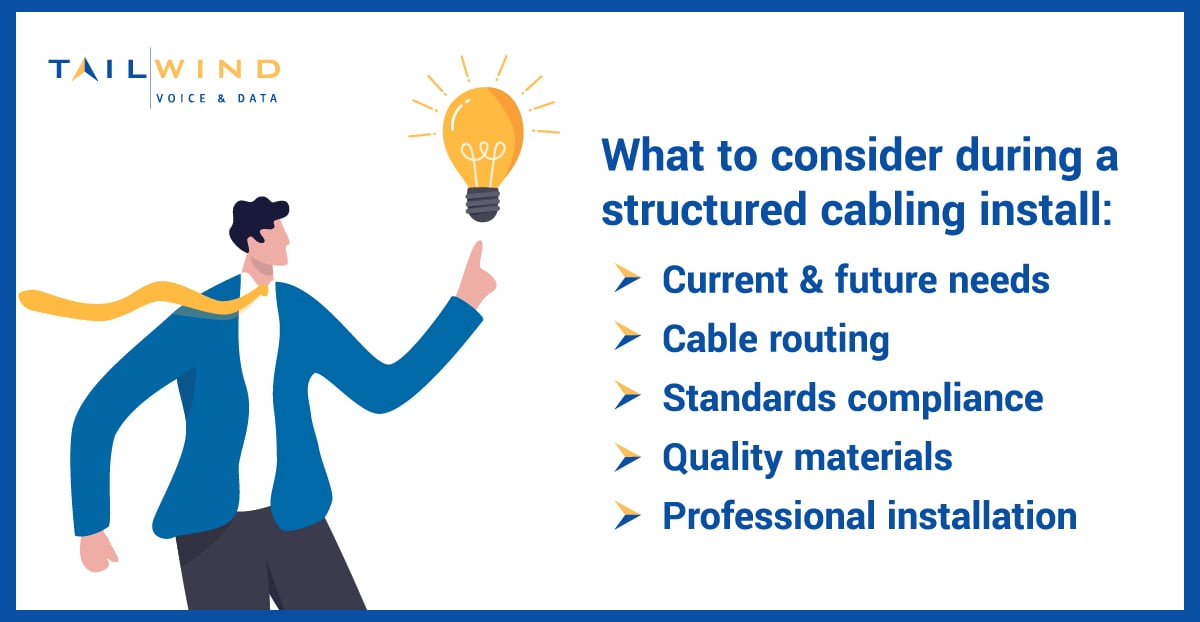
Common Structured Cabling Mistakes & How To Avoid Them
Even the best networks can suffer from poor cabling practices, leading to slow performance, increased downtime, and unnecessary maintenance costs. Below are some of the most common mistakes in structured cabling installation and how to prevent them.
Using The Wrong Type Of Cable
Installing outdated or improper cabling for the network’s needs (e.g., using Cat5e for high-speed applications).
Instead, you should choose cables that meet future bandwidth needs, such as Cat6a for 10 Gbps speeds or fiber optics for long-distance transmission.
Ignoring Cable Management Best Practices
Running cables without proper routing, leaving a tangled mess in server rooms.
Instead, use cable trays, patch panels, and labels to keep cables organized and easy to manage.
Running Network Cables Too Close To Power Lines
Placing Ethernet cables alongside electrical wiring, leading to electromagnetic interference (EMI).
Instead, keep network cables at least 12 inches away from power lines and use shielded cables if necessary.
Failing To Test Cables After Installation
Assuming all cables work correctly without testing connections, leading to undetected faults.
Instead, always perform cable testing with a certification tool to check signal integrity, continuity, and performance.
Ignoring Future Scalability
Installing a cabling system that only meets current needs without considering future growth.
Instead, plan for future expansion by installing extra cabling and using patch panels for easy upgrades.
Not Using Proper Cable Lengths & Exceeding Limits
Running cables longer than recommended, which can degrade signal quality.
Instead, keep Ethernet cable lengths under 100 meters (328 feet) to maintain optimal performance. Use fiber optics for longer distances.
Using Poor-Quality Cables & Connectors
Choosing low-cost cables that lack durability, leading to early degradation.
Instead, invest in high-quality, certified cables and connectors that meet industry standards (TIA/EIA-568).
Overloading Cable Trays & Conduits
Packing too many cables into a tray, leading to heat buildup and physical damage.
Instead, follow cable fill capacity guidelines and avoid excessive bending that could damage cable integrity.
Forgetting Proper Documentation
Failing to document cable routes, making troubleshooting and future expansions difficult.
Instead, maintain detailed network diagrams, cable labels, and structured documentation for easy reference.
Structured cabling mistakes can lead to costly network failures, poor performance, and long troubleshooting times. By following best practices, businesses can build a scalable, high-performance, and reliable network.
Structured Cabling System FAQs
Here are answers to a few frequently asked questions about structured cabling:
What’s The Difference Between Cat5e & Cat6 Cabling?
Cat5e supports up to 1 Gbps between connections of around 300 feet, while Cat6 supports higher frequencies and can handle 10 Gbps speeds up to 700 feet before signal loss.
Should Fiber Cabling Be Used For Structured Wiring?
Fiber optic cabling is often used for backbone cabling between telecommunications rooms and sometimes for horizontal cross-connects to support high network capacity. Fiber wiring has advantages for long distances and noise immunity but can be more expensive than copper cabling like Cat5e or Cat6, which is adequate for many networks.
Can Structured Cabling Support Wireless Networks?
Yes, a properly designed structured cabling infrastructure provides a reliable backbone for Wi-Fi systems.
What Are Patch Panels & How Are They Used In Structured Cabling?
A patch panel has ports that allow cables to be interconnected or cross-connected easily. Patch panels organize and terminate horizontal cable runs and provide the interface to connect network switches and other active equipment in racks via patch cables. This modular approach makes moves, adds, and changes easy to implement on an as-needed basis.
How Often Should You Test A Cabling System?
Structured cabling solutions should be tested upon initial installation, during upgrades, and when troubleshooting.
Should A Professional Install Structured Cabling?
Certified professionals should handle the installation and termination of a cabling system, as improper techniques can degrade cable performance.
Optimize Your Structured Cabling Installation With Tailwind
Structured cabling provides the critical backbone for communication systems that today's businesses rely on. By taking a strategic approach to designing and installing structured cabling tailored to your needs, you can avoid disruptive issues down the road.
When it's time to install or upgrade your cabling, partnering with the right provider is key. TailWind has over 20 years of experience managing structured cabling projects for enterprise businesses of all sizes. We take complete ownership of your cabling installation project, from design to installation to ongoing support – and we'll keep you informed each step of the way. With TailWind, your cabling upgrade will be finished on time, within budget, and with minimal disruption to your daily operations.
Ready for a stronger foundation for your voice and data networks? Reach out to TailWind today to get started.
